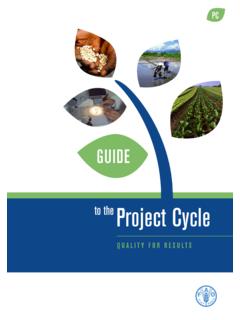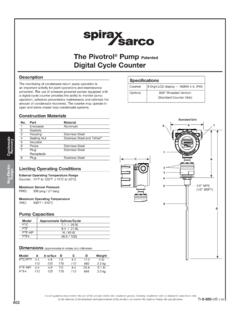Transcription of LIFE-CYCLE PERFORMANCE - cimlinepmg.com
1 16 ASPHALTSUMMER 1999By Dr. Bob Boyer, Asphalt Institute SeniorDistrict Engineer and Jay Hensley, AsphaltInstitute Chief EngineerThe Asphalt Institute s LIFE-CYCLE perfor-mance program now has and is devel-oping a database to store and analyze LIFE-CYCLE PERFORMANCE data and make it avail-able to user agencies. So far, surveyresults show that asphalt pavements areperforming better than previously Climatic ConditionsThe program uses five climatic condi-tions wet freeze, wet no-freeze, dryfreeze, dry no-freeze, or all climatic con-ditions. The traffic, or functional, classi-fication is divided into six differentclasses. Class 1 represents the basicresidential street.
2 The classification pro-gresses upward to Class VI, which isheavy interstate. The constructionlevel is composed of new, rehabilita-tion, or both. Fifty-four service lifeequations can be developed from thedata using the various traffic, construc-tion and climatic conditions for a PCRof service life equations showthat asphalt pavements are not onlyperforming according to design life ,which is normally 20 years, but can bemaintained longer with routine mainte-nance, which may include crack pour-ing, surface treatments, milling andoverlays of nominal aggregate is not normally thoughtto add structural value to the pave-ment, but merely to restore surface forrideability.
3 Safety and environmentalprotection from the DifferencePreliminary data also indicates a signifi-cant difference in pavement perfor-mance for various climatic rehabilitation, or second phaseperformance, is also out-performingestimated design periods, which arenormally 15 years. For major rehabilita-tion, often referred to as reconstruc-tion, pavements are also lasting beyondtheir planned design life . A muchlonger life than that anticipated by theestimate of design life is seen for thetotal range of rehab additional pavement sections areadded to the database, includingSuperpave concepts and new qualitycontrol specs, asphalt pavements areexpected to show even longer perfor-mance periods with less data will be available for furtheranalysis not only by this program, butalso by other procedures as well.
4 Bythe end of 1998 more than 800 pave-ment sections were logged in the data-base. Ultimately, there will be severalthousand pavement sections for thecomplete analysis of all criteria withrespect to Variables FollowAASHTO LeadOver 35 state agencies use theAmerican Association of State Highwayand Transportation Officials (AASHTO)pavement design procedures, or somemodification of them. Many larger cityand county agencies also use thisdesign procedure, or a standard sec-tion, for various streets and roadwaysbased on it. All formal procedures,regardless of the source, attempt toaddress the common issues of designvariables. Since the AASHTO proce-dure is used the most, it is a commonreference on some of the major of the first considerations indesign is design reliability, a statistical-ly based factor that indicates how validthe design is for the input provides a range of reliabilityfactors based on traffic, as do other for-mal design procedures (See Table 1).
5 When higher reliability factors areused, the pavement design is propor-tionately thicker. Most agencies willselect the 85 to 90 percent reliabilityfor the higher traffic levels. A reliabilityfactor of percent is fairly commonfor most high-traffic designs. Havingheavier traffic than expected in thedesign period often negates the designmore than any other factor. Designingat 95 percent reliability or above is pro-hibited by cost for most volume roads and streets typi-cally specified by ordinance or stan-dard sections fall into a 50 to 70 per-cent range of design preliminary data from the per-formance program shows a wider vari-ation in the PERFORMANCE life of ClassesI to III than for Classes IV to VI.
6 Thelevel of maintenance may not be ashigh for the lower volume roads, whichTable 1. Design Reliability Factors for Functional ClassificationsPercent Recommended Level of ReliabilityFunctional ClassificationUrbanRuralInterstate & Freeways85 to to Arterials80 to 9075 to 95 Collectors80 to 9575 to 95 Local (Low Volume)50 to 8050 to 80 life -CYCLEPE RFORMANC EASPHALT 17 SUMMER 1999could contribute to a wider band inthe PERFORMANCE curve. The Institute straffic classifications are presented inTable 2. All facilities were placed intothe appropriate traffic classificationbased on equivalent single axle load(ESAL) design AffectsPavement PerformanceEnvironmental factors can and doaffect pavement PERFORMANCE , andextreme moisture and temperaturevariations appear to be the most com-mon factors.
7 When both are present,this combination can affect thestrength and durability, as well as theload carrying capacity, of the exposure to these extremeconditions destroys the structuralcapacity of the effects under the various envi-ronmental conditions are normallydegrading to the structural coefficientsthat are originally assigned to the mate-rials. This has to be taken into consid-eration in long-term pavement perfor-mance. Level of maintenance isextremely important as environmentalfactors are considered, and may be anissue in the spread of PERFORMANCE onlower-volume MaintenanceThe loss of serviceability, or a decreasein present condition rating, can be theresult of both traffic and environmentalfactors.
8 Appropriate and timely mainte-nance, which may include crack seal-ing, cross-slope, shoulder and generaldrainage improvements in conjunctionwith some surface restoration, canretard environmental effects on theloss of X 1031041051063 X 106107 Type of ClassStreet or Highway Parking lots, driveways Light traffic residential streets Light traffic farm roads Residential streets Rural farm and residential roads Urban minor collector streets Rural minor collector streets Urban minor arterial and lightindustrial streets Rural major collector and minorarterial highways Urban freeways, expressways andprincipal arterial highways Rural interstate and other princi-pal arterial highways Urban interstate highways Some industrial roadsApproximate Range-NumberOf Heavy Trucks for Design life <7,0007,000 15,00070,000 150,000700,000 - 1,500,0002,000,000 4,500,0007,000,000 15,000,000 Table 2.
9 Traffic ClassificationsTrafficClassIIIIIIIIIIIII IIIIIIVIVIVVVVVIVIVINew333333 Rehab333333 Both333333 WetFreezeXXXXXX92016184130372434X2632 Wet NoFreezeXXXX99X1011X34X313838X2121 DryFreezeXXXXXX47323936X43X2738X2529 Dry NoFreezeXXX211720272527X3533XX15 XXXALL24X18201317231921344639492935X2528 Type of ConstructionTable 3. Projected Service life of Hot Mix Asphalt1 Climatic Conditions1 Service life projected to a PCR of 70 indicates surface restoration be = insufficient dataLIFE-CYCLEPE RFORMANC ELIFE-CYCLE18 ASPHALTSUMMER 1999 The pavement sections for climaticconditions of dry freeze and dry no-freeze appear to have the best overallservice life , based on this preliminarydata.
10 Right now the study is short onprojects from the dry no-freeze projected service life for a PCR of70 is presented for the classificationsthat have a significant amount of data(See Table 3). As more data is collected,current values are expected to , as the R2 of the correlationequation increases, the projected ser-vice life decreases up to a given some of the cells, there s notenough data to make a valid correla-tion. The categories of all climatic con-ditions and both categories for the con-struction level, should provide an over-all estimate of the life expectancy ofeach roadway facility, before majorrehabilitation or reconstruction will life Decay Curve The typical and traditional polynomialcurve often used to illustrate the decayor service life of pavements was notseen in the PERFORMANCE equations.







